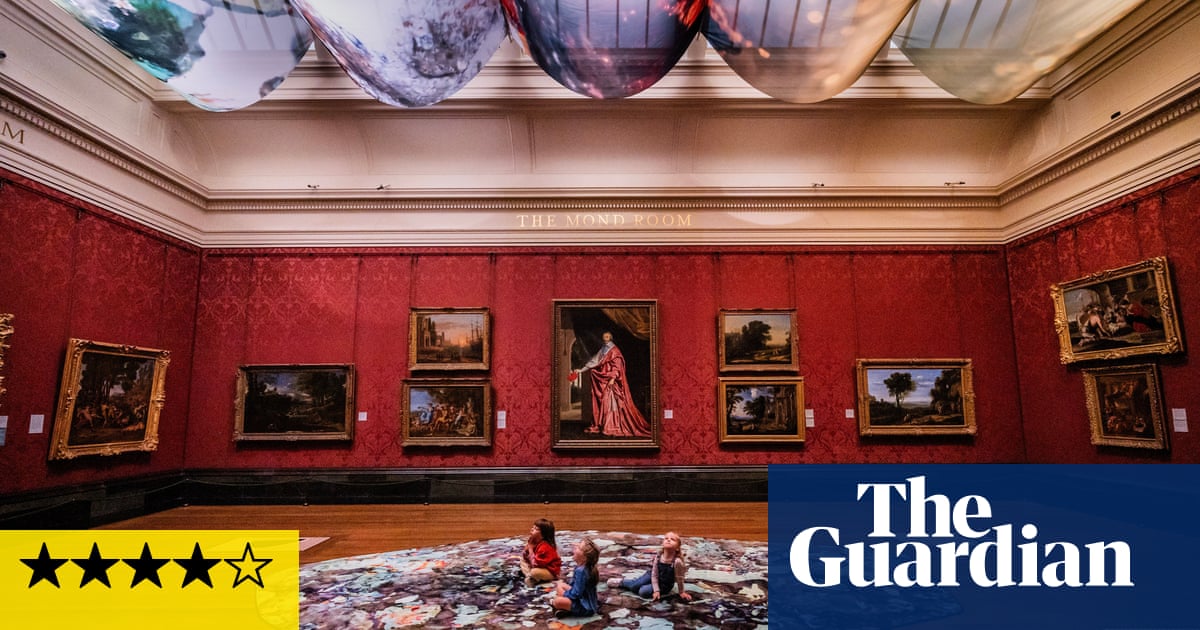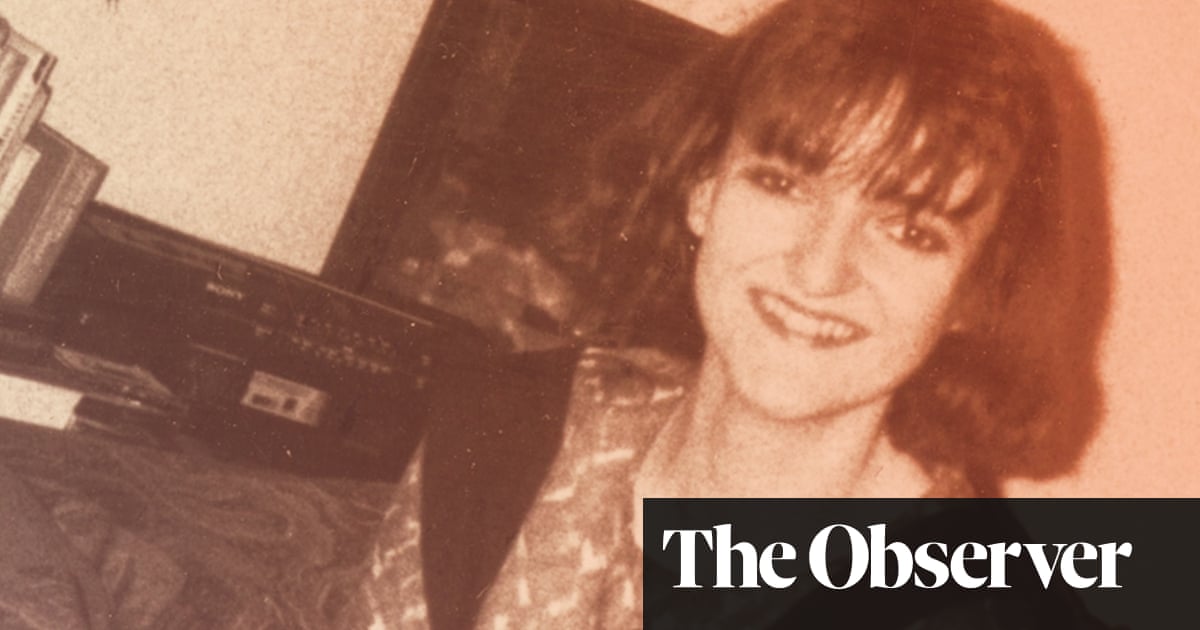
Céline Condorelli’s Pentimenti (The Corrections), in Room 31 at the National Gallery only works if you let it. Intriguing, disarming and seductive, Condorelli’s work occupies a gallery dedicated to 17th-century French painting, a room dominated by several works by Nicolas Poussin and by Philippe de Champaigne’s imposing full-length portrait of Cardinal de Richelieu, Louis XIII’s first minister, and a collector of Poussin’s art.
Some will find Conderelli’s low-key intervention puzzling at best, if not infuriating, among the works by Claude and the Le Nain brothers, and above all Poussin, the enigmatic and sometimes haunting and bawdy classicist. Condorelli’s presence does not interfere. A printed rug on the floor, called Bulk: Everlasting Colour; a dyed textile, The Sun Shines Through a Hole in the Clouds, is slung beneath the skylights overhead; a series of shapes – The Force that Seems to Beckon – are painted on the metal grilles set into the floor over the gallery’s air ducts, and a four-channel audio Uprisings (Troppo Lento), composed by Hannah Catherine Jones (AKA Foxy Moron), plays from beneath the grilles. All this is less an ensemble of discreet artworks by the National Gallery’s current artist in residence, than a starting point.
Condorelli’s large rug sits on the gallery’s varnished wood floor; its off-kilter, five-sided shape has a kind of fractal relationship to the coloured tessellations that dapple its surface with colour. The rug is an invitation: to walk over it, to sit, to lie face up or down, and watch from ground level the feet of visitors going from one painting to the next. As they circulate, some visitors avoid the rug, as though it were forbidden territory, and barely gaze up at the translucent textile that Condorelli has draped under the skylight high above. The fabric slung between the struts in the ceiling’s recess sags like the sail of a becalmed boat. Lying on the rug, I’m becalmed, too. Noticing how the droops in the fabric echo the rhythmic rise and fall of the green security rope making its way between its regularly positioned little posts down by the floor, I’m adrift in the swell. Looking up, there’s stuff floating about up there. Out-of-focus drifts of globules and hazy constellations, or things seen through a microscope, printed on Condorelli’s translucent textile, mingle with the daylight coming through the glass and the rank of spotlights that augments it.
Lounging on the rug, I’m either a sunbather or a slacker. In a minute I might crawl over to the wall – or as close as the rope barrier allows – to take a look at the magnificent carved and gilded frame, with its curlicues and heads and sprays of fanciful foliage, that surrounds Poussin’s 1633-4 Adoration of the Golden Calf, but I’m not sure crawling is allowed.
Below the wall label describing Poussin’s painting, a small, second label tells us that the artist often mixed naturally occurring iron earth pigments in his paints, for reasons other than their visual effect, and that Condorelli has followed Poussin’s “attempts to unite perspective, atmospheric optical effects and material properties, together with humankind’s relationship to nature and the world” in her own work here. Poussin’s reasons for using these particular admixtures of pigment may have assisted in the grinding of his other colours, or given his paints extra bulk or flow, or altered their transparency or helped temper their tonal values. Who knows. Analysis by the National Gallery’s scientific department provides such a surfeit of information about the materials used by artists – right down to the molecular level – to a degree of complexity that no current computer can crunch all the information provided by these scanners and 3D mapping devices.
Condorelli has redirected the gallery’s scanning apparatus to further analyse the materials in the room itself – the marble skirting, the wood floor and the wall linings – and used these scans in the production of the abstract patterning of the rug and the hanging textile.
Each of the cast-iron gratings set into the gallery’s floor has been painted over with a biomorphic abstract shape, based on the profiles of the mouths of the dragons that appear in paintings in the National Gallery’s collection. These works might be found in some of the other rooms, in works by Uccello and Tintoretto, Ingres and Moreau. There’s a link, I guess, between what we might imagine as the roar of these fanciful and frightening beasts and the sounds rising from the ducts beneath the gratings. Wandering the gallery by night during her residency, Condorelli was struck by the way the underfloor air ducts hoovered up the ambient noise of the locale, from Trafalgar Square and Leicester Square, and drew it into the otherwise quiet galleries. By day, you can’t hear the city’s hum and shouts. With its bass lines and classical lilts and strains, snatches of nearly inaudible dialogue, shouts and chants from political demonstrations, distant clamour and Swing Low Sweet Chariot sung by a Welsh choir, Jones’s sound work drifts in and joins the footfalls and whispers, the coughs and mutterings of the people moving through the room.
Apart from Condorelli’s additions, there’s nothing here but the paintings that usually hang. To which one might add the sweep of the varnished wood floor, the bevelled green marble skirting, with its variously toned tiles at the foot of the walls, the rope barriers and the burgundy damask wall-covering, whose sheen alternates light and dark as we move about in front of its subdued floral pattern. There’s the skylight and the artificial lighting, the labels and the picture frames, and the name of the room itself, picked out in gold between the mouldings at the top of the wall. Every detail, from the colour of the walls to the lighting, to the decisions made about what hangs where, at what height, and in what order – all these decisions made about placement and light levels serve to direct us to what sits within the carved and moulded frames, with their layers of wood and paste and burnished gilding, all choreographed in such a way as to guide us round the walls of this cul de sac and out again, through the same door we came in by.
Condorelli wants us to become aware of the gallery as a “viewing device”, both a social space and a machine for looking. But what is our attention being led to? She wants to direct us to things seen and unseen, to physical conditions and to mental states, things in-between the acknowledged and the misunderstood, the ignored and the revered, to history and the personal.











